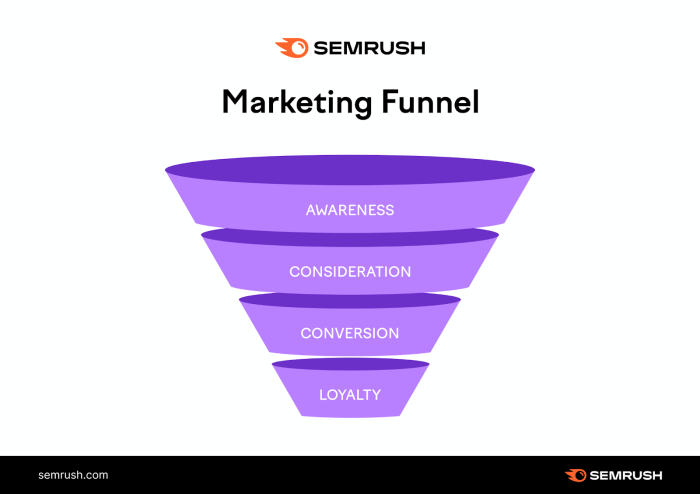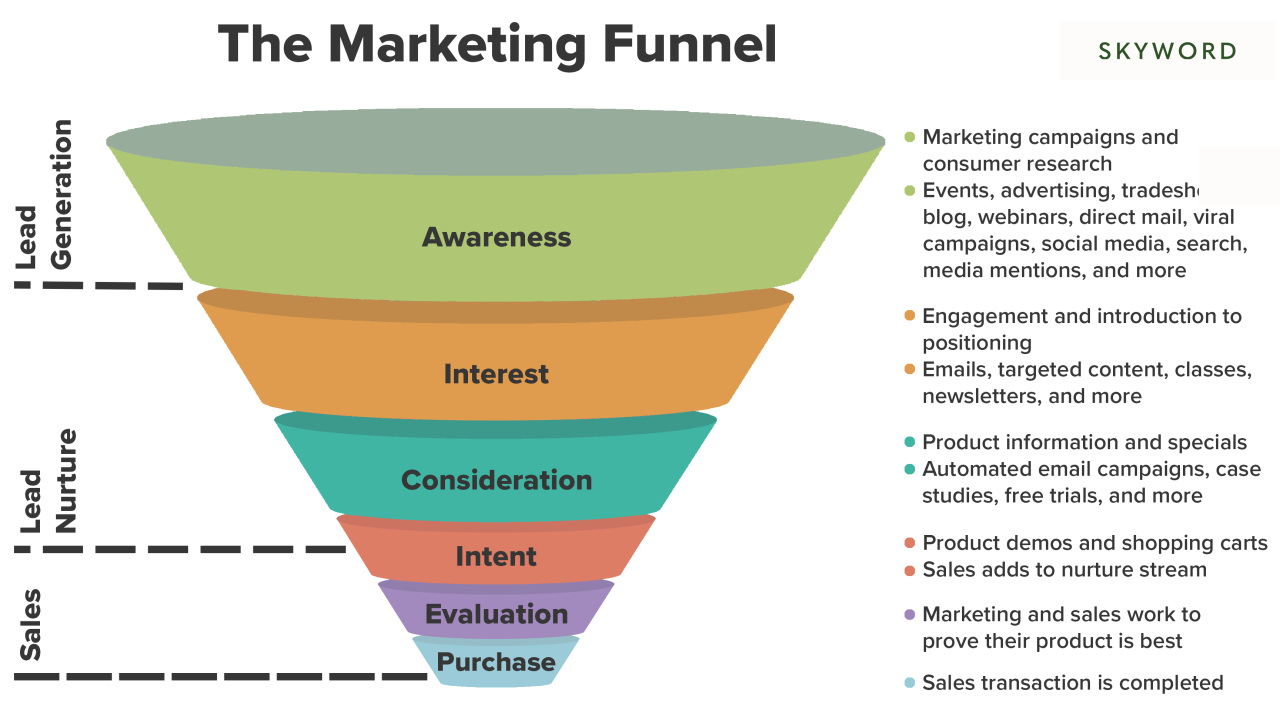Understanding Marketing Funnels sets the stage for a wild ride through the world of sales strategies and conversions. Get ready to dive deep into the top, middle, and bottom of the funnel with a twist of creativity and expertise.
Get ready to uncover the secrets behind successful marketing funnels and how they can skyrocket your business to new heights.
Introduction to Marketing Funnels
A marketing funnel is a visual representation of the customer journey from the initial interaction with a brand to making a purchase. It consists of different stages that guide potential customers through the buying process.
Marketing funnels are crucial for businesses as they help in understanding customer behavior, optimizing marketing strategies, and ultimately increasing sales and revenue. By analyzing each stage of the funnel, businesses can identify areas for improvement and tailor their marketing efforts to better meet the needs of their target audience.
Common Stages of a Marketing Funnel
- Awareness: This is the stage where potential customers become aware of the brand or product through various marketing channels such as social media, search engines, or advertising.
- Interest: At this stage, customers show interest in the product or service and start to engage with the brand by visiting the website, signing up for newsletters, or exploring more information.
- Decision: In this stage, customers evaluate the options available and decide whether to make a purchase. They may compare prices, read reviews, or seek additional information before making a decision.
- Action: The final stage of the funnel where customers make a purchase and convert into paying customers. This is the ultimate goal of the marketing funnel.
Top of the Funnel (TOFU)
The top of the funnel (TOFU) is the initial stage in the marketing funnel where potential customers are first introduced to a brand or product. The main purpose of this stage is to create awareness and attract a wide audience.
Purpose of the Top of the Funnel Stage
At the TOFU stage, the focus is on casting a wide net to reach as many potential customers as possible. The goal is to create brand awareness, generate interest, and educate the audience about the products or services offered. This stage is crucial for capturing the attention of leads and establishing a connection with them.
Examples of TOFU Marketing Strategies
- Content Marketing: Creating blog posts, articles, and videos to provide valuable information to the audience.
- Social Media Marketing: Engaging with followers on platforms like Facebook, Instagram, and Twitter to build brand awareness.
- : Optimizing website content to improve search engine rankings and attract organic traffic.
- Webinars and Events: Hosting online webinars or in-person events to showcase products or services.
Differences in TOFU Content, Understanding Marketing Funnels
At the TOFU stage, the content is more general and educational, focusing on addressing the pain points of the target audience without directly promoting specific products or services. The content is designed to spark interest and build trust with the audience. In contrast to content in other funnel stages, TOFU content is meant to attract a broad audience rather than target specific leads.
Middle of the Funnel (MOFU)
The middle of the funnel stage plays a crucial role in the marketing funnel as it focuses on nurturing leads that have shown interest in your products or services. At this stage, potential customers have moved past the awareness phase (TOFU) and are considering making a purchase. It is essential to provide them with valuable information and build trust to guide them towards conversion.
Lead Nurturing Techniques for MOFU
Lead nurturing in the middle of the funnel involves engaging with potential customers and providing them with targeted content to address their specific needs and concerns. Here are some effective lead nurturing techniques for MOFU:
- Personalized Email Campaigns: Tailor your email campaigns to provide relevant content based on the lead’s previous interactions with your brand.
- Content Offers: Offer valuable content such as whitepapers, case studies, or webinars to educate leads and move them closer to making a purchase decision.
- Automated Workflows: Set up automated workflows to deliver the right content at the right time based on lead behavior and engagement with your website.
- One-on-One Interactions: Personalized interactions through phone calls or personalized messages can help build a stronger relationship with leads.
Remember, the key to successful lead nurturing in MOFU is to provide valuable and relevant content that addresses the lead’s needs and challenges.
Significance of Personalized Content in MOFU
Personalized content is crucial in the middle of the funnel as it helps to build a stronger connection with leads and increases the chances of conversion. By delivering content that is tailored to the lead’s interests and preferences, you can provide a more personalized experience that resonates with them. Personalization can include addressing the lead by name, recommending relevant products or services, and providing content that aligns with their stage in the buying journey.
- Increased Engagement: Personalized content leads to higher engagement rates as leads are more likely to interact with content that is relevant to them.
- Builds Trust: Tailoring content to the lead’s needs and interests helps to build trust and credibility, making them more likely to consider your brand for their purchase.
- Higher Conversion Rates: Personalized content can lead to higher conversion rates as leads feel understood and valued, increasing the likelihood of them moving further down the funnel.
Bottom of the Funnel (BOFU)

In the bottom of the funnel (BOFU) stage, the main objective is to convert leads into customers. This is where the focus shifts towards driving sales and getting potential customers to make a purchase. The goal is to provide the necessary information and incentives to push leads towards making a buying decision.
Conversion Tactics in BOFU
- Offer Free Trials or Demos: Providing a free trial or demo of your product or service can help potential customers experience its value firsthand.
- Use Case Studies and Testimonials: Showcasing success stories and testimonials from satisfied customers can help build trust and credibility, making it easier for leads to convert.
- Provide Limited-time Offers: Creating a sense of urgency through limited-time offers or discounts can encourage leads to take action and make a purchase.
- Implement Remarketing Campaigns: Targeting leads who have shown interest but haven’t converted yet with personalized ads can help bring them back to complete the purchase.
Examples of BOFU Content
- A Comparison Guide: Creating a comparison guide that highlights the benefits of your product or service over competitors can help leads make an informed decision.
- Customer Success Stories: Sharing real-life examples of how your product or service has helped customers achieve their goals can be compelling and persuasive.
- Exclusive Discounts: Providing exclusive discounts or offers to leads who have shown interest but haven’t converted yet can be a powerful incentive to make a purchase.
Creating a Successful Marketing Funnel: Understanding Marketing Funnels

To design a high-converting marketing funnel, you need to follow a strategic approach that guides potential customers through the buying process. This involves creating engaging content, understanding your target audience, and optimizing each stage of the funnel for maximum conversions.
Steps to Design a High-Converting Marketing Funnel
- Identify Your Target Audience: Conduct market research to understand the needs, preferences, and behaviors of your ideal customers.
- Create Compelling Content: Develop relevant and valuable content that resonates with your audience at each stage of the funnel.
- Build Landing Pages: Design landing pages that are visually appealing, easy to navigate, and optimized for conversion.
- Implement Email Marketing: Use email campaigns to nurture leads and guide them through the funnel with personalized content.
- Optimize for Conversions: Test different elements of your funnel, such as CTAs, copy, and design, to improve conversion rates.
Importance of Tracking and Analyzing Funnel Metrics
Tracking and analyzing funnel metrics is crucial for evaluating the performance of your marketing efforts and identifying areas for improvement. By monitoring key metrics such as conversion rates, bounce rates, and customer acquisition costs, you can make data-driven decisions to optimize your funnel and increase ROI.
Tips for Optimizing Each Stage of the Marketing Funnel
- Top of the Funnel (TOFU): Focus on creating awareness and attracting leads through engaging content and targeted advertising.
- Middle of the Funnel (MOFU): Nurture leads with personalized emails, case studies, and product demos to build trust and drive conversions.
- Bottom of the Funnel (BOFU): Offer incentives, discounts, and testimonials to encourage leads to make a purchase and become loyal customers.
